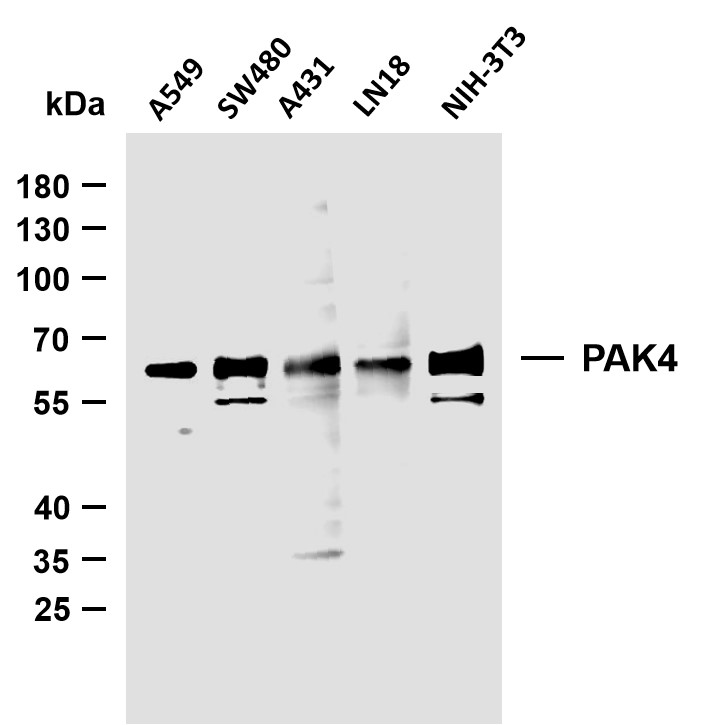PAK4 (PTR1350) mouse mAb
- Catalog No.:YM4535
- Applications:WB;IF;ELISA
- Reactivity:Human;Mouse;
- Target:
- PAK4
- Fields:
- >>ErbB signaling pathway;>>Ras signaling pathway;>>Axon guidance;>>Focal adhesion;>>T cell receptor signaling pathway;>>Regulation of actin cytoskeleton;>>Human immunodeficiency virus 1 infection;>>MicroRNAs in cancer;>>Renal cell carcinoma
- Gene Name:
- PAK4
- Protein Name:
- Serine/threonine-protein kinase PAK 4
- Human Gene Id:
- 10298
- Human Swiss Prot No:
- O96013
- Mouse Gene Id:
- 70584
- Mouse Swiss Prot No:
- Q8BTW9
- Immunogen:
- Synthesized peptide derived from human protein.AA range:400-500
- Specificity:
- This antibody detects endogenous levels of PAK4.
- Formulation:
- PBS, 50% glycerol, 0.05% Proclin 300, 0.05%BSA
- Source:
- Mouse, Monoclonal/IgG3, kappa
- Dilution:
- WB 1:500-2000. IF 1:100-500. ELISA 1:1000-5000
- Purification:
- Protein G
- Storage Stability:
- -15°C to -25°C/1 year(Do not lower than -25°C)
- Other Name:
- PAK4;KIAA1142;Serine/threonine-protein kinase PAK 4;p21-activated kinase 4;PAK-4
- Molecular Weight(Da):
- 64kD
- Observed Band(KD):
- 68,52kD
- Background:
- PAK proteins, a family of serine/threonine p21-activating kinases, include PAK1, PAK2, PAK3 and PAK4. PAK proteins are critical effectors that link Rho GTPases to cytoskeleton reorganization and nuclear signaling. They serve as targets for the small GTP binding proteins Cdc42 and Rac and have been implicated in a wide range of biological activities. PAK4 interacts specifically with the GTP-bound form of Cdc42Hs and weakly activates the JNK family of MAP kinases. PAK4 is a mediator of filopodia formation and may play a role in the reorganization of the actin cytoskeleton. Multiple alternatively spliced transcript variants encoding distinct isoforms have been found for this gene. [provided by RefSeq, Jul 2008],
- Function:
- catalytic activity:ATP + a protein = ADP + a phosphoprotein.,function:Activates the JNK pathway. Plays a role in the reorganization of the actin cytoskeleton and in the formation of filopodia. Phosphorylates and inactivates the protein phosphatase SSH1, leading to increased inhibitory phosphorylation of the actin binding/depolymerizing factor cofilin. Decreased cofilin activity may lead to stabilization of actin filaments. Phosphorylates ARHGEF2.,PTM:Autophosphorylated on serine residues when activated by CDC42/p21.,PTM:Phosphorylated on tyrosine residues upon stimulation of FGFR2.,similarity:Belongs to the protein kinase superfamily. STE Ser/Thr protein kinase family. STE20 subfamily.,similarity:Contains 1 CRIB domain.,similarity:Contains 1 protein kinase domain.,subunit:Interacts with FGFR2 and GRB2 (By similarity). Interacts tightly with GTP-bound but not GDP-bound CDC42/p21 and weakl
- Subcellular Location:
- 0
- Expression:
- Highest expression in prostate, testis and colon.
- June 19-2018
- WESTERN IMMUNOBLOTTING PROTOCOL
- June 19-2018
- IMMUNOHISTOCHEMISTRY-PARAFFIN PROTOCOL
- June 19-2018
- IMMUNOFLUORESCENCE PROTOCOL
- September 08-2020
- FLOW-CYTOMEYRT-PROTOCOL
- May 20-2022
- Cell-Based ELISA│解您多样本WB检测之困扰
- July 13-2018
- CELL-BASED-ELISA-PROTOCOL-FOR-ACETYL-PROTEIN
- July 13-2018
- CELL-BASED-ELISA-PROTOCOL-FOR-PHOSPHO-PROTEIN
- July 13-2018
- Antibody-FAQs
- Products Images

- Various whole cell lysates were separated by 4-20% SDS-PAGE, and the membrane was blotted with anti-PAK4 (PTR1350) antibody. The HRP-conjugated Goat anti-Mouse IgG(H + L) antibody was used to detect the antibody. Lane 1: A549 Lane 2: SW480 Lane 3: A431 Lane 4: LN18 Lane 5: NIH-3T3



